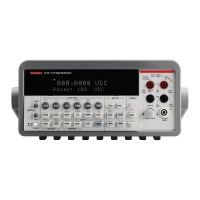B-24 Return to Section Topics 2100-900-01 Rev. D / September 2011
Appendix B: Remote Interface Reference Model 2100 6 1/2-Digit Resolution Digital Multimeter User’s Manual
• Enable ìoperation completeî by using the *ESE 1 command.
• Send the *OPC? command and enter the result to enable synchronization.
• When bit 5 is set in the status byte summary register, please use a serial poll to check. Then
users could set the DMM for an SRQ interrupt by using *SRE 32.
Usage of the Messages Available Bit (MAV)
You can use the status byte “message available bit 4” to decide when data is available to read in
the bus controller. When the first reading trigger occurs by using the command
TRIGger:SOURce:IMMediate, the DMM will automatically enable the bit 4. The DMM will clear bit
4 only after entire messages have been read from the output buffer.
The MAV bit can indicate only when the first reading is generated by the READ? command. So this
will be helpful for users as a trigger event such as BUS or EXTernal will occur. In addition, the MAV
bit is set only after all specified measurements have completed by using the INITiate and FETCH?
commands. That means in detail, the INITIate command is used to store readings in the DMM’s
internal memory. And the FETCH? command is used to transfer readings to the DMM’s output
buffer.
Signal by Using *OPC When Data is in the Output Buffer
Normally, to use the “operation complete bit 0” in the standard event register will signal as a
command sequence is completed. The bit is set in the register after executing an *OPC command.
And if users send an *OPC after a command loading a message in the DMMís output buffer, the
operation complete bit is allowed to be used to determine as the message is available. However, if
there are too many messages generated before executing the *OPC command, the output buffer
will be filled, and the DMM will be interrupted to take readings.
About the Standard Event Register
The standard event register reports the instrument event types below, such as power-on detected,
command syntax errors, command execution errors, self-test (calibration errors), query errors or
the moment of executing an *OPC command. Then through the enable register, all conditions will
be reported in the standard event summary bit. At the moment, users have to write a decimal value
by using the *ESE command to set the enable register mask.
NOTE The errors in the DMM’s error queue except reading the error queue by using
SYSTem:ERRor? will be recorded by an error condition (including bits 2, 3, 4 or 5 of
the standard event register).
NOTE In both the standard event register bit 3 and the questionable data event register bits 0, 1
or 9, a reading overload condition can be reported all the time. But in the DMM’s error
queue, no error message will be recorded.
The following table shows the definitios for the Standard Event Register (see Table B-2).
Table B-2
Definition of the Standard Event Register
Bit Decimal
Value
Definition
0. Operation complete 1 All commands prior to and including an *OPC command have
been executed.
1. Not used 2 Set to 0.
2. Query error 4 The DMM output buffer was empty as the DMM tried to read
from it. Or, a new command line was recieved before a previ-
ous query has been read. Or, both the input and output buffer
are full.

